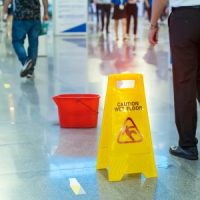The Role of Signage in Tampa Slip and Fall Lawsuits

Most Tampa residents are familiar with “wet floor signs.” These ubiquitous yellow stands are common across numerous malls, grocery stores, restaurants, and other establishments. Although these signs might be common, many residents are unaware of their legal significance. Could a simple sign prevent you from suing after a slip and fall in Tampa?
Signs Make You Aware of Fall Hazards
The purpose of a sign is relatively clear: They make people aware of potential hazards. If you see a “wet floor” sign, you have been warned about the slippy nature of the floor. As a result, one might argue that a reasonable person would avoid that floor section or walk with extreme caution.
Aside from wet floor signs, many other types of signage warn people of various threats. Another example is a sign that warns people about electrocution risks. Another sign might warn gas station customers about oil spills.
The Concept of “Awareness” in Personal Injury Lawsuits
Many property owners in Tampa recognize the importance of “awareness” in personal injury claims. A sign could represent an effective defense strategy if the property owner can prove you became aware of the hazard before your fall.
The general logic is simple: If you were aware of the hazard, then you could have taken reasonable steps to avoid the accident. Although this might seem unfair, it is a recognized legal doctrine in Florida – and one that could prevent you from recovering compensation.
Can I Still Sue if There Was a Wet Floor Sign?
While signage could represent a challenge for injured plaintiffs, it does not necessarily prevent them from recovering compensation. Even if there was a sign, it might not have been clear. If the lettering was too small for you to make out the words, you could argue that you were never made aware of the hazard. The property owner may have placed the sign in an awkward location. Perhaps it was blocked by a food display, or maybe you approached the spill from an angle where the sign was not visible.
In addition, signs are only supposed to be a temporary measure. For example, a grocery store staff member might notice a spill and place a sign nearby to warn customers. Staff must then take reasonable steps to clean the spill as quickly as possible. If they simply leave the spill sitting there, this could constitute negligence – even with the presence of a sign. A reasonable staff member would immediately get a mop and begin cleaning the spill.
Can a Slip and Fall Lawyer in Tampa Help?
Although warning signs can pose certain challenges for injured plaintiffs, an experienced slip and fall lawyer in Tampa can help you overcome these roadblocks as you seek fair compensation. Warning signs do not represent a “get out of jail free card” for negligent property owners in Florida, and you can push back with decisive legal strategies. Contact Anderson & Anderson to get started with an action plan today.
Sources:
cleanmanagement.com/blog/a-brief-look-at-the-7-step-process-of-a-spill-response/
kaivac.com/articles-news/grocery-and-retail/cleaning-spills-on-grocery-store-floors/?srsltid=AfmBOoq8OKifaEQ3dAF-m8VuH79tTt1_1Uv_uHgQOwvjltSKDGq8IaFf
